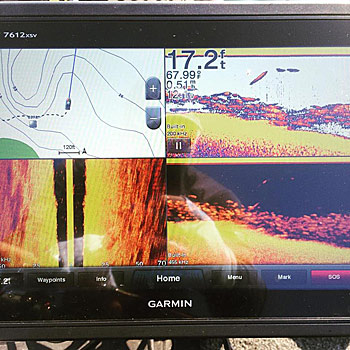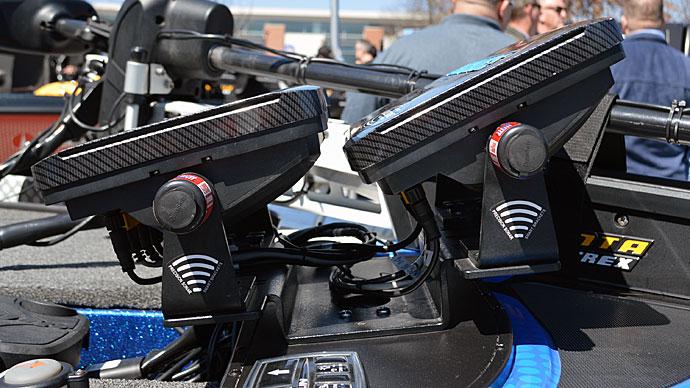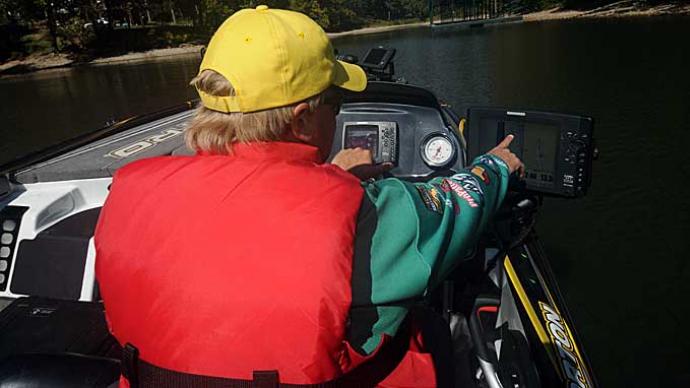
There was a time, not that long ago when bass anglers felt empowered with a fish-finder on the bow and one at the console of their boat. They reported the depth, bottom, contour, fish, and water temperature to catch bass effectively. Then things changed.
Anglers began carrying pH meters, Color-C-Lectors, and other auxiliary electronic devices that measured environmental conditions and kept track of the moon phase. Some even used Loran navigation units. The precursor of today’s GPS units, they triangulated position using towers and radio signals. Then came a revolution in fishing electronics. Graphs began incorporating color. GPS, which traded Loran’s hit-or-miss towers for super-accurate satellites, was taking anglers from dock to spot, over and over again. Then top tournament anglers started rigging their boat with four units, which featured larger screens — some a foot or more across — that simultaneously showed more sonar and mapping information.
Now, the world has become live with the advancement of forward-facing sonar. Anglers are now running two or even three units at the bow, each dedicated to a specific purpose.
The race for larger, more powerful, and increasingly intricate fishing electronics isn’t slowing down. Lowrance, Garmin, Humminbird, and other manufacturers unveil more technology every summer at the ICAST fishing industry trade show.
Today’s fishing electronics technology is impressive, but you’ll have to open your wallet and spend some time learning to use it to utilize all of its benefits. And those might come from adding additional units or ones with newly developed features. That has left some bass anglers asking if the investment can be recouped with more bass. Paul Mueller has a simple answer to that question, which is a resounding yes.
The Naugatuck, Conn., angler, who caught the heaviest five-bass limit in Bassmaster Classic history — 32 pounds and 3 ounces at Lake Guntersville — has established himself on the Bassmaster Elite Series. He’s also bagged two Elite Series wins on Lake Lanier and the St. John’s River. Competing there requires him to travel the country and fish waters different from those in his home state. He often only has a few days to scout them before the tournament begins. That makes his electronics even more critical.

Mueller said his electronics help him find and catch bass consistently. That’s because they reveal structure, cover, and other data, such as water temperature, that help him understand how bass react to their environment at that moment. In fact, during practice, he spends more time watching his electronics than putting a line in the water. He estimates it’s a 60 percent to 40 percent split.
Mueller has a lot to look at. Today’s electronics offer many different ways to see the underwater world. Almost every unit includes traditional sonar, which has become easier to read with color. Down scan gives you a detailed view of bass-holding structure and cover; trees look like trees, and individual fish can be discerned from a school. Side-scan lets you see the bottom along the sides of your boat. It lets you cover more water with each pass because you aren’t relying on just one transducer cone orients structure and cover. Humminbird even offers a 360-degree view, which allows you to see around your boat without moving it.
Mueller’s boat is rigged with four units. They are Garmin’s top-end units: three 7612xsv units, which have 12-inch screens, and one 7610xsv, which has a 10-inch screen. They have many features: touch-screen menus, down scan, side scan, GPS, and mapping. He runs two of the 12-inch units on the boat’s console, and the remaining 12-inch and 10-inch ones are on the bow. The larger screens and multiple units let him quickly see all the different functions at once and in greater detail.
Let’s say he is idling river ledges on a Southern impoundment. Across the two units, he can open windows with traditional sonar and down scan to get two pictures of what is under his boat. He can also pull up a side-scan to widen his perspective and the GPS and maps to see where he is on the lake. The windows are large, so he can zoom in for detail and still see enough to keep things in context, especially on his maps, which use 1-foot contours. That level of detail reveals not only spots on spots but also the spot on the spot.
The same strategy holds when Mueller’s at the front of his boat. He can pull up the sonar and down scan to watch bass react to his lures and the GPS to ensure he is approaching a particular piece of underwater structure at the perfect angle. But why does he need the unit with the smaller screen? It’s dedicated to a relatively new technology that he said is completely changing how he fishes.
At a Bassmaster Elite Series stop at 185,000-acre Toledo Bend Reservoir, which straddles the Louisiana-Texas line, Mueller discovered that in the morning, when the wind was up, and the amount of light was down, he could catch bass on a variety of deep-diving crankbaits, including Strike King’s giant 10XD. But in the afternoon, when the wind slowed, the water flattened, and the bass turned lethargic, he had to switch tactics to keep getting bites. So, he picked up his drop-shot rod and turned on the smaller unit at his feet.
Mueller uses it to display Panoptix LiveScope, the forward-looking, real-time sonar developed by Garmin. The transducer is mounted on the trolling motor. “It’s looking wherever the [trolling motor’s directional] arrow is pointed,” he said. It shows baitfish, bass, drop-offs, and other pieces of structure and cover. It can see those depths up to about 50 feet from the boat. Knowing what’s in the water in front of him is essential because it helps him make more precise presentations. “It’s a game-changer,” he said. “If you don’t see it, you don’t know it’s there. It’s something that helped me at Toledo Bend.”

Bassmaster Elite Series Angler Paul Mueller was an early adopter of forward-facing sonar and used the original version of Panoptix to land a top-five finish at the Toledo Bend Reservoir stop in May 2016. It gives a real-time look at what is happening underwater in front of his boat.
As Mueller crossed that lake’s expansive flats, which sat in 15 to 25 feet of water, his Panoptix pointed out high spots and the wood scattered on them. He couldn’t quickly cover water with the drop shot, so he motored between the spots his electronics found. They produced some key bites and helped him to a fifth-place finish with 81 pounds and 12 ounces.
Mueller said Panoptix does more than find small pieces of cover scattered across large flats. He also uses it while fishing rip-rap banks. It shows where larger rocks and points are, but he also said it shows his lure and any bass following it. That gives him fair warning, letting him stop his boat and not spook bass.
That’s how Scott Martin used his Panoptix at an FLW Tour event on Lake Champlain. It allowed him to stay back from submerged vegetation and rocks and know exactly where to cast to them. He caught 74 pounds and 10 ounces, enough for his third win on the natural lake that stretches more than 100 miles along the New York-Vermont line.
Since then, forward-facing sonar has become even more prevalent, with all three major brands producing their version.
All this new technology can be intimidating, especially for bass anglers that remember when having a flasher was a big deal. However, Mueller advised anglers not to worry. Regardless of the manufacturer, many touch-screen units operate like a smartphone. It just takes a little time to master them. “It took me about a day to get familiar with it, navigating the unit and using all that the units offer,” he said.
What will the next generation of fishing electronics offer? That’s anyone’s guess. Based on what’s been rolled out already, nothing is too extreme. Garmin engineers, for example, have already created an app that can record images on units and send them to a smartphone. And Mueller said the units he runs could connect to Garmin’s VIRB cameras. But there’s always room for more.
For example, take Garmin’s Nautix product. The small, wireless device attaches to the temple piece of your sunglasses and projects vital data from your electronics, such as water temperature, depth, and speed over the ground, into a corner of your view. Think of it as heads-up display fighter pilots use but with fewer data. How could that be useful? Imagine the spawning season when you run the back of bays or coves searching for beds. You can keep scanning for beds while knowing which corner of the bay has the warmest water and how deep bass are spawning, all without looking down at your unit.
Whichever direction fishing electronics go, they’ll plug you into more fishing success. But the key is taking the time to understand how these items function and how to apply the information to the fishing situation you are facing at the moment.



